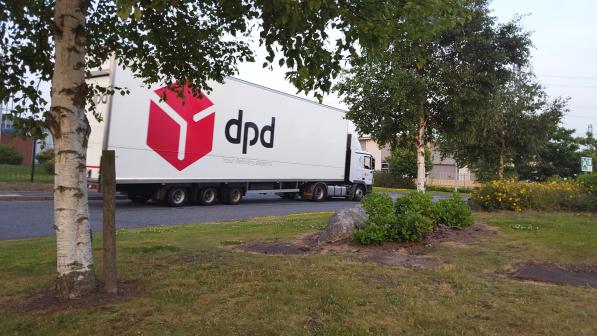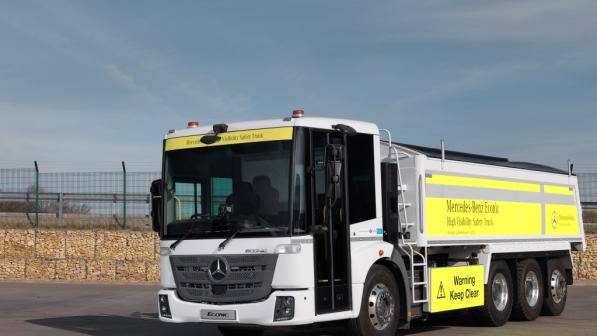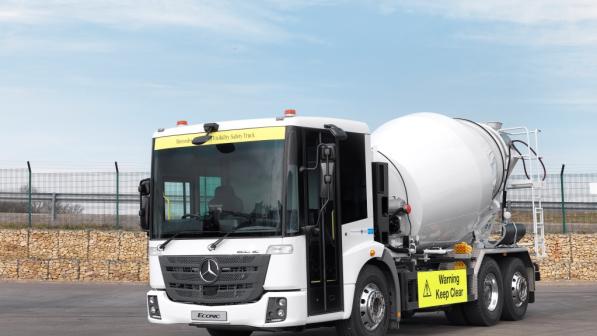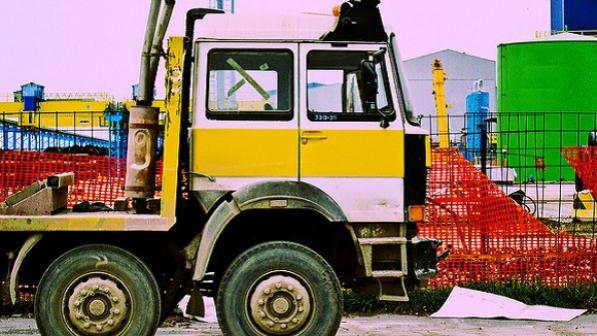Stings in the tail: Cycling UK dismayed by monster lorries roll-out

One summery morning recently, I sat on a bus in a dilemma: should I break it to my three-year-old granddaughter that our sparkly crystal grotto expedition may be off?
Our driver stood outside glaring ahead and everyone on board sat glaring ahead too. Stuck in the act of trying to turn left into a minor street in Guildford, the unmoving flank of a huge HGV trailer jammed our path; and time was ticking down to our grotto-viewing slot.
I don’t know what sort of HGV it was or whether it had squeezed into the street by design or mistake, but it was patently far too monstrous for a tight junction in a town busy with shoppers.
Lorries have their place but, quite obviously, not every place is appropriate.
So why is the Department for Transport (DfT) letting longer semi-trailers loose on Great Britain’s road network with only 'light regulation'? (Access to Northern Ireland will depend on the rules there).
What is a longer semi-trailer (LST)?
Next time you see a typical lorry trailer, imagine 2.05 metres (about 6.5 feet) extra on its tail-end.
Alternatively, imagine stacking just three maximum length LSTs on end with their tractor units in Trafalgar Square and, at 18.55 metres each, they’ll be a fair bit higher than Nelson’s hat.
What’s the fuss all about?
From the DfT’s point of view, there appears to be very little fuss. They set up a trial in 2012 and don’t see any point in waiting until the end date of 2027 before allowing LSTs 'into general circulation with light regulatory control on their use.' Happily for them, this is their 'preferred option'.
From the point of view of LST-curious hauliers, the fuss is all good. LSTs can carry four more pallets than a standard trailer, and it’s estimated that the c2,600 vehicles on trial ‘saved’ 1 in 12 trips on average (1 in 7.5 at best).
So, really, what’s all the fuss about?
From Cycling UK’s point of view, it’s about physical safety, scary journeys and what’s going to happen outside trial settings.
Just for a start, being overtaken by any very long and very large vehicle when you’re on your bike is extremely intimidating.
But it’s worse than that: the sad fact is that the bigger and heavier the vehicle involved in a collision with a vulnerable human being, the smaller the odds are of surviving it.
HGVs normally account for 3.4% of all motor traffic mileage on Great Britain’s non-motorway roads. But from 2015-19 these vehicles were involved in 15.5% of cyclist (78 / 502) and 11% of pedestrian deaths (245 / 2,252). In other words, HGVs are disproportionately involved in cyclist and pedestrian fatalities.
As for the LSTs on trial, one of them was involved in a cyclist fatality (more on this later).
But, you may ask, don’t HGVs mostly travel on motorways only in the company of other motor vehicles? Yes, but it’s for the bulk of the distance, not the vast bulk: 59% of the distance travelled by Great Britain’s standard articulated fleet is on motorways, and only a touch more by LSTs (62%).
HGVs travel extensively on 'A' roads too – 39% (of standard fleet mileage) and 36% (LST). By choice or unavoidably, these roads are vital routes for many people who ride their bikes. What’s more, the 'A' roads favoured by HGVs are predominately rural, a road class that carries only about 4% of cycle mileage, but is the scene of almost a quarter of cyclist fatalities.
Major problems on minor roads
Now for minor roads.
True, HGVs don’t clock up the miles there and nor did the LSTs on trial at 2%. This may sound small, but when lorries finally turn off motorways and head for local depots or retail stores, it’s then that their most complex manoeuvring usually begins.
It also happens to be where they’re most likely to meet people who are walking or cycling – footfall is high and about 83% of all cycling takes place on minor roads. Add LSTs into the mix, and we think we have every right to be alarmed about the safety and comfort of vulnerable road users.
The DfT itself acknowledges that 'LSTs would be expected to perform most high angle turns' in urban locations or on minor roads. But perhaps the most worrying thing of all is this: their extra length translates into an extended tail-swing, something that may not be apparent to anyone in the near vicinity.
As Action on Lorry Danger (ALD), a coalition including Cycling UK, put it to the then transport minister Jesse Norman in November 2018:
“Many urban and local roads in the UK are unlikely to be able to accommodate such large vehicles, requiring them to perform movements that put other, more vulnerable, road users at risk, such as mounting kerbs or traffic islands; swinging over kerbs, traffic islands or adjacent lanes; and entering adjacent lanes, parking bays or footways.”
We simply can’t gloss over the risk that HGVs pose to cyclists and pedestrians when they’re in close proximity: London’s Direct Vision Standard, for example, is the result of fatality after fatality.
Many urban and local roads in the UK are unlikely to be able to accommodate such large vehicles, requiring them to perform movements that put other, more vulnerable, road users at risk
Action on Lorry Danger
But casualties aside, more goods per trip = good news for the environment, doesn’t it?
It helps to put on your rose-coloured glasses here: recalculations suggest that up to the end of 2020 the LST trial saved 60,000 tonnes of carbon dioxide equivalent (CO2e) and 92 tonnes of oxides of nitrogen (NOx).
Far be it for me to appear ungrateful, but this doesn’t seem an awful lot in the scheme of things - in 2019 alone, HGVs emitted 19.5 million tonnes of CO2e in the UK, and 22 thousand tonnes of NOx in 2018. In any case, fuel efficiency among HGVs may well be offset by an uptick in registrations of larger/heavier vehicles, something’s that already happening.
Also, articulated HGVs travel around 15 billion vehicle kms in a single year in Great Britain, while the LSTs on trial only saved around 66 to 73 million vehicle kms over nine years (525,000 to 582,000 journeys).
But casualty-wise, the LST trial proves there’s nothing much to worry about, doesn’t it?
The latest analysis states that, compared with the average for all Great Britain's articulated HGVs, per km the LSTs were involved in: '… about 47% fewer personal injury collisions'; and '90% fewer personal injury collisions… when operating on roads in urban areas and 68% fewer when on minor roads'.
Also, the LST injury incident rate for vulnerable road users in all locations 'appears to be lower… but the difference in rates does not pass a classical statistical significance test.' This conclusion isn’t all that reassuring, but can’t be helped given the small sample size.
Altogether, the analysis lists 46 injury incidents that happened in public locations during the trial. Four of these involved someone either walking or cycling:
- A cyclist fell off and died while an LST was overtaking (legal proceedings pending).
- An LST driver, who said he was dazzled by the evening sun, hit a cyclist from behind when moving from a slip road to an dual carriageway, which forms part of a bypass around a major town. The cyclists was seriously injured.
- An LST, turning right from a minor road into an industrial estate, clipped a youth said to be 'messing about'.
- The tail-end of an LST slightly injured a pedestrian while making a very high angle turn in an urban location during a driver assessment.
Only the last of these incidents is thought to be related to the longer length of the vehicle, however.
Be that as it may, the key word here for us is ‘trial’. The DfT had to conduct their experiment with a new type of huge vehicle on the roads of Britain very carefully indeed.
Thus the voluntary participants, operating at their own cost and risk, were on their best behaviour, specially training their drivers, closely assessing routes and, under pain of losing their Vehicle Special Order (VSO), self-reporting data to the DfT’s consultants (originally, at least).
Success, and the greater productivity and profits that would flow from it, depended on compliance and safe practice. No wonder they largely kept out of trouble.
We are not talking about the real world here. We know, just as the DfT knows, that 'remaining issues, relating to the safety, can only be answered outside of trial settings.'
But hasn’t the DfT thought about the real world?
Yes, but only up to a point. Opting to regulate LSTs 'lightly', DfT expects operators to comply with existing HGV rules, plus, for example:
- risk assessing routes and recording the results
- checking that set routes are followed, and dealing appropriately with deviations and road closures
- facilitating and recording drivers’ feedback and their response to it
- providing specific driver training 'lasting a minimum of half a day'.
To put this is in context, the DfT toyed with but rejected the idea of expecting each LST to run on major roads for at least 80% of each journey, along with far more intensive training for drivers through the certificate of professional competence.
But, even if they’d gone for this heavier option, would the future look much less alarming for us?
The future
We’re now facing what could be an LST mushroom from January or April next year. Projections suggest 'that in a decade’s time about 16,000 LSTs could be operating – approximately 8 to 10% of the UK’s domestic semi-trailer fleet.'
It'll be over to the real world, a world of thousands of 'lightly regulated' LSTs, of myriad and sudden diversions round back streets and country lanes, bad sat-nav directions, hauliers potentially scraping around for qualified drivers; and pressurised firms and their workers, some of them rogue, cutting corners.
Any hope?
We can only hope that the promised technical measures to reduce tail-swing or kick-out will both manifest and work, and that the ‘savings’ LSTs make in terms of trips, albeit modest, translate into fewer casualties.
We also hope that councils will use their powers to restrict or ban LSTs from unsuitable streets; site depots responsibly; plan for onward delivery by friendlier vehicles; and not start redesigning junctions to accommodate such large vehicles and, in doing so, make them a (worse) nightmare for people on foot or bike.
We don’t want this to be a 'told you so' story about putting productivity over cyclists and pedestrians’ safety, but we’re not convinced.
Anything for local campaigners to do?
Yes please.
Check online for your local authority's statements and policies about large goods vehicle movements in their area and see if you're happy about the way they're regulating them. With your local knowledge, you're in the best position to check for any deficiencies and raise them with the appropriate contacts.
Don't forget that Cycling UK supports the Cycle Advocacy Network for the people and groups who make cycling better for everyone. If you're not already involved, find out more.
By the way, my granddaughter and I reached the crystal grotto by a whisker; but, had it been an LST jammed in the way, I rather think we’d have been walking back to the bus station to brood on a change of plans.



